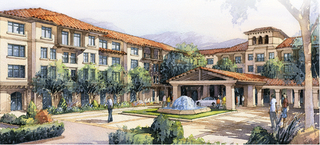The MonteCedro retirement community is still alive, say representatives from the Episcopal Home Communities, altho’ it will be smaller, less costly, and will be built in phases.

At last night's Altadena Town Council meeting, Episcopal Homes Communities president Marty Tamburrano said that within 30 days they will begin marketing the development, which is to go on the empty lot that formerly held the Scripps Home, and are aiming for a 2015 opening of the first phase.
The MonteCedro development has been stalled since the collapse of the housing and tightening of credit markets last year, when Episcopal Homes informed 300 prospective residents that they were putting the project on hold.
Now that prospects look brighter, the development is moving ahead, Tuamburrano said, albeit with some changes. The new development will now consist of a large main building, with three “villa-size” buildings of ten apartments each, one to be located on El Molino and two on Calavaras. The four villas planned for Crawford St. will be part of the second phase of development.
The project overall has been scaled down: where there were formerly 234 independent living apartments, there will now be a total of 226 -- 186 in phase one, and 40 in phase two. Assisted living units have been reduced from 38 to 20 in the new plan. The buildings will now cover 201,950 sq. ft, where it was formerly 203,510 sq. ft. A planned indoor swimming pool has been moved outside to save expenses, and underground parking has been reduced, MonteCedro representatives said.
Tamburrano said that they require that the project be 70% presold before construction can begin -- which means receiving a 10% downpayment on 70% of the units. They expect sales and marketing to last from 18-24 months, with construction projected to start in July 2013 and move-in by the middle of 2015.
When Episcopal Homes Communities acquired the property, Scripps Home residents moved to the Kensington facility in Alhambra with the promise that they could return to Altadena if they wanted. Tamburrano said that they plan to construct enough units at MonteCedro for those who want to move in, if they can, and that funds have been set aside to pay for their care. The subsidy to former Scripps Home residents will be $15-$18 million over their lifetime, Tamburanno said.
Normally, fees run from $2,500 to $5,000 per month.
The whole complex is designed for an “aging in place” model, where residents remain in their apartment while increased care is being brought to them as long as they want to stay there, rather than moving residents to units that provide increasing amounts of care. The exceptions are the assisted living units, which are primarily for dementia care, Tamburrano said.
Tamburanno also apologized for the state of the property, which has become overgrown with weeds. Episcopal Homes has hired a new landscaping company, which will be there once or twice a week to mow, trim, and chop weeds. In addition, there is now security in place at the property. The netting attached to the fence, which is torn or cut in many places, will be removed and by October the site will be hydroseeded with grasses, mulch, and wildflowers.
Episcopal Homes has also been spreading around largesse: it has commissioned a multigenerational art project of schoolchildren and seniors to decorate a wall on the property, and is giving $10,000 to the sheriff’s station to pay for crime-fighting equipment, Tamburanno said.



